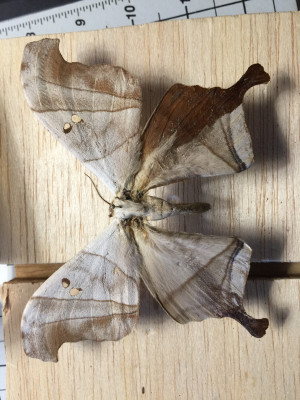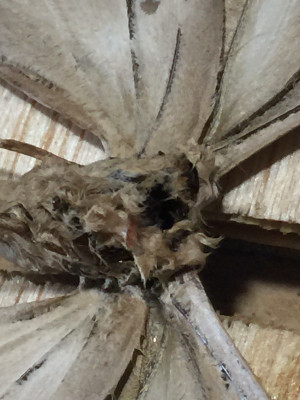|
|
Post by martina on Jun 3, 2014 10:34:26 GMT -8
Hi,
I read lots of advice about using the acetone for degreasing butterflies but not sure for how long would you leave them in. Any experience? Thanks
|
|
|
|
|
|
Post by nomad on Jun 3, 2014 10:57:17 GMT -8
Hi, I have often degreased Ornithoptera bodies. I take the abdomens off and give them three baths, a couple of days each. I have used acetone, but usually Ethyl Acetate. I dislike the look of greased bodies and it can spread to the wings.
|
|
|
|
Post by ash on Jun 3, 2014 14:37:59 GMT -8
Hi,
I have been advised that as acetone dries very quickly it can in some instances buckle wings. Therefore I have only used acetone on some Coleoptera and not on Lepidoptera. Shellite (lighter fluid) and petroleum / gasoline can also be used. Complete immersion of the specimen for 24 hours followed by fan drying is what I have tried recently. On moths and hairy specimens (like Coscinocera hercules) the hairs clog together and look a bit displeasing. The abdomen of male Ornithoptera could take longer to degrease so one option as advised by nomad it can be removed and degreased for longer separately. However if you remove the abdomen prior to relaxing for spreading, remember that relaxing fluids will soften the contents from the thorax and this could also leak onto the wings and these can be also hard to clean.
I tend to feel that completely degreased specimens would be less likely to get insects attacking them - has anyone else got more experience with this?
Ash
|
|
|
|
Post by martina on Jun 5, 2014 3:47:50 GMT -8
Thank you.
If you leave them i acetone for a day or longer, how do you seal it? Acetone seems to dissolve everything but glass.
I've read excelent Bill's ”three bath process”, but even there he doesn't say, how long is each.
So for now it (opinions) ranges from an hour to days. I need to degrease some Saturnidae, abdomens of Ornithoptera, and Goliathus beetle.
Any more ideas, experiences?
|
|
|
|
Post by nomad on Jun 5, 2014 8:53:24 GMT -8
Hi, Put the Acetone is a glass jar with a lid. I have found that three baths- each two days works the best for the bigger abdomens. When they are finished, as they dry, I blow on them, so the hairs maintain their original appearance.
|
|
|
|
Post by wollastoni on Nov 4, 2020 3:04:19 GMT -8
Anyone know if we can use acetone to degrease butterfly WINGS ? I have a rare Agrias that has its HW greasy but would like to know if we can put a full butterfly into acetoe, or if I will totally ruin it.
Thank you.
|
|
|
|
|
|
Post by exoticimports on Nov 4, 2020 4:25:32 GMT -8
Anyone know if we can use acetone to degrease butterfly WINGS ? I have a rare Agrias that has its HW greasy but would like to know if we can put a full butterfly into acetoe, or if I will totally ruin it. Thank you. I've done it, but see Ash's observation above. You may want to try a similar, disposable specimen first. Chuck |
|
|
|
Post by trehopr1 on Nov 4, 2020 11:40:28 GMT -8
My singular experience with complete immersion was not a good one. I had a greasy wing stained Black Witch moth. I went with a friends advise and immersed it in acetone for 30 minutes. I removed it, and used a blow dryer on it to hopefully un-mat the hair on the body. Well, that did NOT fluff up any of the body hair and I even found that the long hair covering the hind wings partially looked worse and even somewhat matted after the immersion. The hair on the wings prior looked fine, sleek, and natural beforehand. So, I presumed that some of the leached out oils mixed with the acetone and created that (new) issue.
Also, then came the wing curling. In a very short time (in hours) both fore and hind wings curled (bowed) significantly "upward" looking very un-natural. I took the specimen to the relaxer and put it in for a day. I then re-spread it and used several glass strips to weight down the wings to hopefully make them flat again. Left it that way for a month...
I removed everything and found within a week the wings once again curled upward (bowed) just as bad as after immersion and within about a month it was greasing up again !
Now, maybe some would say that I did not leave it long enough in acetone to effect a truly good de-greasing. However, the "wing curling" issue WAS an after-effect of immersion (not before); and it only made things worse as the specimen looked so un-natural in pose. The weighted glass on those wings made absolutely no difference to making them flat again !
This was my bad experience as such. I would not recommend immersion myself particularly because of the possibility of wing curling. In my case, I happened to have another 4 witch moths which I had collected so in the advent of eventually being "displeased" with its overall appearance; I tossed it in the trash. No, great loss as I had others and the species is worth little money. However, yours is probably pricey and as you say somewhat rare so I would not mess with it...
If anything --- (and if its appearance bothers you enough); maybe re-sell it or trade it to someone less concerned about appearance. As we all know, most insects are a re-newable resource and some time down the road you will likely see another close in appearance to yours.
Just my humble opinion.
|
|
|
|
Post by exoticimports on Nov 4, 2020 12:57:47 GMT -8
Scary story hopr1.
As I’ve detailed before, I found rubbing alcohol to be more effective. It will somewhat soften the specimen.
Chuck
|
|
|
|
Post by wollastoni on Nov 5, 2020 2:38:30 GMT -8
By "rubbing alcohol", you mean isopropyl alcohol right ?
You would use it the same way as acetone by immersing the Agrias one night in it ?
Scary story indeed trehopr, Agrias have thick wings so I hope it will be fine
|
|
|
|
Post by exoticimports on Nov 5, 2020 4:22:55 GMT -8
My experience has been with limited experimentation, and it certainly is worth more in-depth experiments to determine a best solution to an old problem.
I use 65% isopropyl alcohol in a tupperware (plastic) sealed box.
The question is why not use 90%? I don't know. Would it act like acetone? I believe the wing curling problems with acetone are excessive removal of all resident moisture in the specimen. Likewise, specimens bathed in acetone also become very brittle. It is possible that 90% alcohol does the same. So this is only a theory.
In my experience, as soon as the oil hits the alcohol it runs off fast. This though may depend on the amount of oil and the type of wing surface it is on. Again, I do not know. All I can say is that in my experience the oil runs off very quickly and I can see the dark oils as they enter the clear alcohol.
I would not immerse the entire specimen, I'd immerse only the minimum possible. This is due to risk of changing the wing colors, matting the "hairs" etc. Will the alcohol change these features? I do not know; they have not in my LIMITED experience, since primarily I've done beetles and only a few butterflies.
In my experience, a butterfly would not need to be in the alcohol for more than a few seconds. With large dynastes, 90% of the observed oil departed the specimen within two minutes. I'm thinking a butterfly wing should take only seconds.
Note that while I've used the alcohol bath quite a bit, I have NOT used it on greasy Ornithoptera for risk of damaging the specimens. So I am suspect of my own methods.
Such an experiment wouldn't be difficult, many of us have multiples of the same greasy species. For me, it's a matter of time available.
Chuck
|
|
|
|
Post by wollastoni on Nov 5, 2020 4:30:40 GMT -8
Thanks a lot Chuck !
If it takes few second, I will dip only the hindwings (as the forewings are not touched by the greasiness).
And I will of course try on a cheap Agrias before.
My greasy specimen is a female Agrias phalcidon fournierae form viridiflavus. Can cost more than $800 on the market.
|
|
leptraps
Banned
Enter your message here...
Posts: 2,397
|
Post by leptraps on Nov 5, 2020 6:10:40 GMT -8
I have experimented with Acetone and it is the safest to use. The best however, is Ether. I acquired a gallon (??) In the early 1990's. It does not leave a stain.
Most of my greasing problems have been with female specimens. Should the majority of the specimen greased, I break off the Abdomen and decrease it seperately. A short bath normally decreases the wings, Head and Thoracs.
It is not a perfect system. Works better on smaller specimens.
There was a Lepidopterist in South Florida (Homestead area) 1990's who used Carbontetrachloride. He claimed it was the best. (I can still see him but cannot remember his name.)
|
|
|
|
Post by johnnyboy on Nov 5, 2020 12:41:46 GMT -8
The problem with pure acetone is that it has a strong affinity for water and will dry specimens out too much, it can crack the wings of butterflies and moths. It can also have a bleaching effect as some pigments are soluble in it and gets leached out from the insect, particularly if the specimen is left to soak for more than a few hours. I have found that toluene is far superior as a degreasing agent. It is pretty non toxic, smells pleasant (in my opinion at least) and doesn't dry the insect out. 48 hours in a toluene bath at room temperature will effectively degrease most things.
Johnny
|
|
|
|
Post by exoticimports on Nov 5, 2020 13:02:13 GMT -8
URGENT READ!!! Having used isopropyl alcohol on many large beetles and some small butterflies, I figured what the heck, go for broke. BROKE INDEED! I had specimens of a saturnid from Central America. One had quite a bit of grease on the UPS LHW, so I though it would photo well. 70% fresh alcohol. I placed the specimen in, upside down. In about 10 seconds it was completely submerged. 15 seconds after it hit the alcohol I pulled it out by the pin, and the wings drooped as if it were softened; then kept going. RFW fell off entirely. This was a previously dried specimen that I softened then set, probably two or three years ago. Thus, I know there was no glue holding it together. UPS before:  UNS before:  Submerging:  After 15 seconds:  After drying through the night. The whole thing is weightless, like a shell, so glue to secure all wings.  Result of alcohol bath on wing oil: zero. No change. Chuck |
|